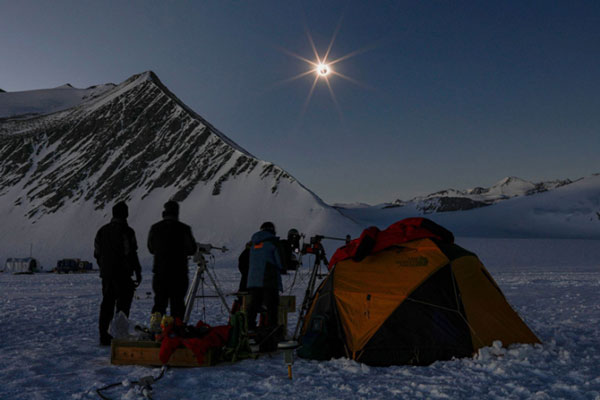The total solar eclipse lasted nearly 2 minutes and was only observable in Antarctica, where scientists conduct research and where penguins live.

American and Chilean scientists observing the eclipse from Union Glacier camp, Antarctica, on December 4. Photo: Felipe Trueba/Imagen Chile/AFP
The eclipse began at 2:00 PM and ended at 3:06 PM on December 4 (Hanoi time), with the totality phase occurring at 2:44 PM, lasting less than 2 minutes. During a solar eclipse, the Moon moves between the Sun and the Earth, casting a shadow on the blue planet. In a total solar eclipse, the Sun, Moon, and Earth align perfectly in that order.
Those located at the center of the Moon’s shadow on Earth could witness this fascinating astronomical phenomenon. They would see the sky darken as the Moon’s shadow swept across the Earth. Those in Antarctica, the only place where the total eclipse could be observed on December 4, would also see the Sun’s outer atmosphere, or corona. Normally, this atmosphere is obscured by the bright surface of the Sun.
Time-lapse video capturing the solar eclipse from Union Glacier camp, Antarctica. Video: Space
Currently, Antarctica is experiencing summer (lasting from October to February), when the Sun is almost always in the sky. This means that about 4,400 to 5,500 people, including staff and researchers, are on this continent, significantly fewer than the number of penguins. The British Antarctic Survey (BAS) estimates that there are approximately 20 million breeding pairs of penguins in Antarctica.
Although the total solar eclipse was not visible, astronomy enthusiasts in some other parts of the world could observe a partial eclipse. These areas included Saint Helena, Namibia, Lesotho, South Africa, South Georgia, the Sandwich Islands, the Crozet Islands, the Falkland Islands, Chile, New Zealand, and Australia.
The next total solar eclipse will occur on April 20, 2023, visible in the southern and eastern regions of Asia. Meanwhile, the next partial solar eclipse will take place earlier, on April 30, 2022, visible in the southeastern Pacific and some areas of South America.


















































